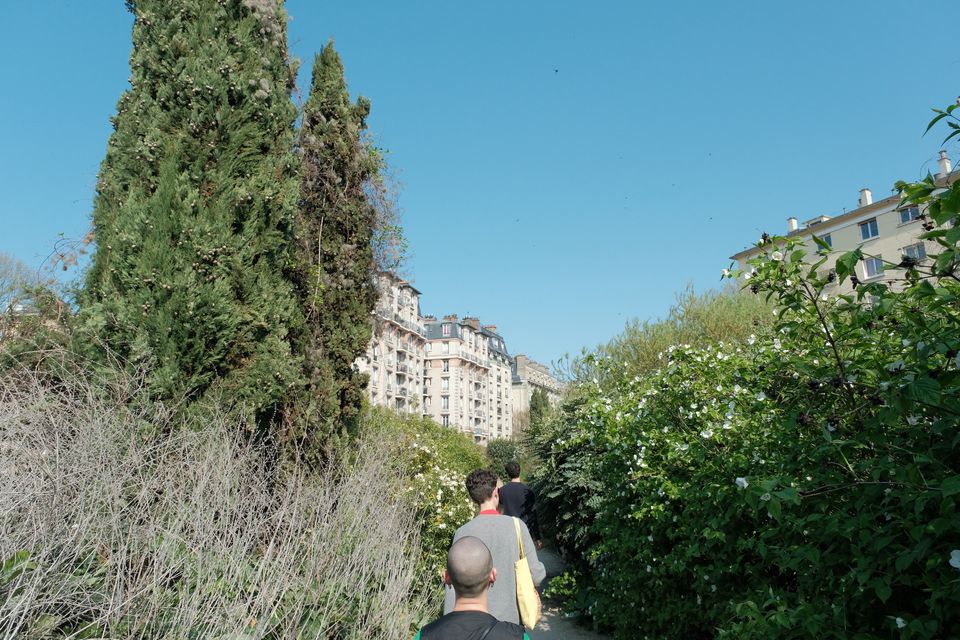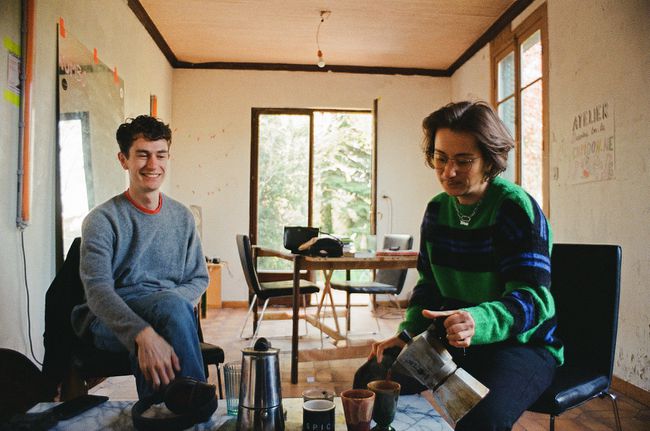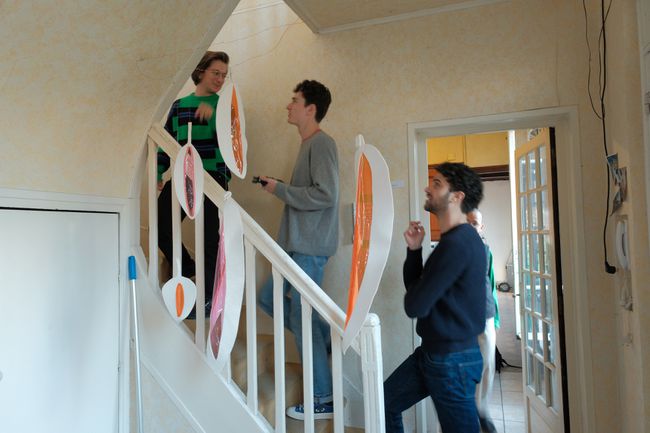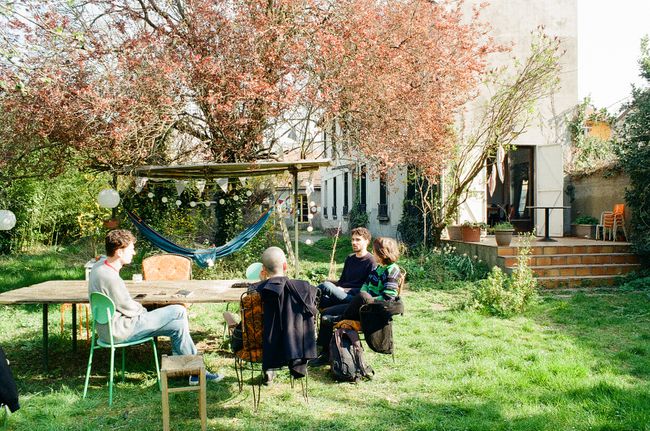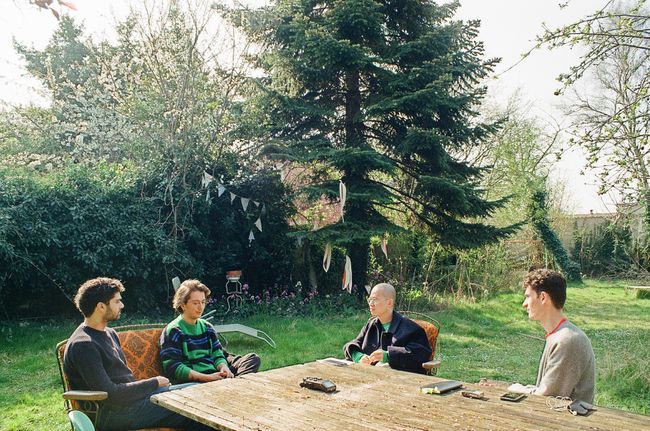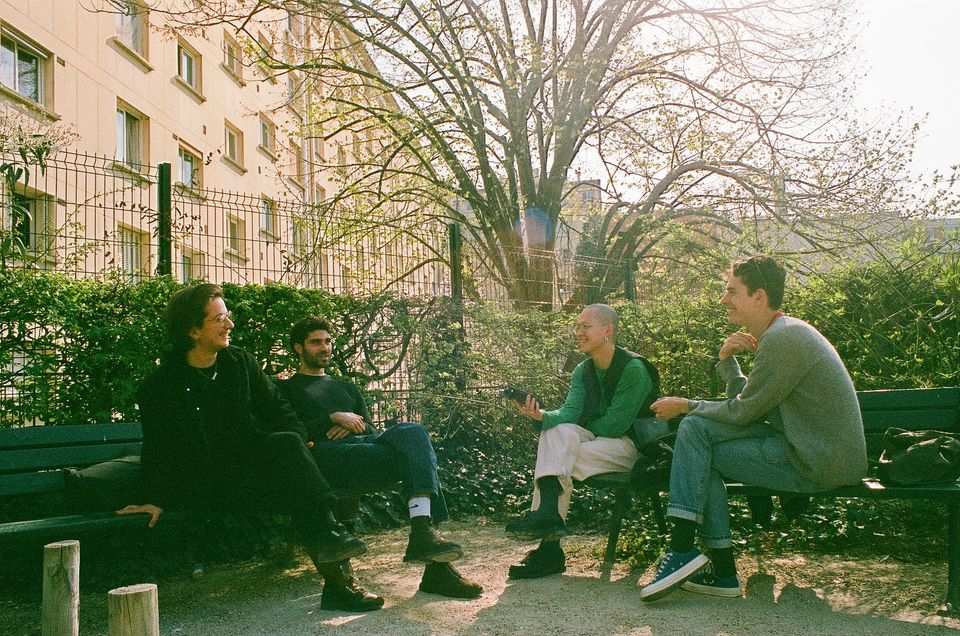Paris: Between Collective Practices and Searching for Queer Spatialities in the City
Bui Quy Son and Paul-Antoine Lucas of Exutoire speak with Mahé Cordier-Jouanne and Jean Makhlouta about queer methodologies and the notion of decentring in architecture
Paris, 9:45am, a chilly spring morning
We exited the metro at Porte de Bagnolet on the eastern outskirts of Paris and took a bus toward Romainville. At 10am, we arrived at the doorway of “La Garompola”; the nameplate on the doorbell reads “Mr. et Mme. Garompolo.” Mahé and Jean arrived five minutes later. We began the recording around a table in the garden of the associative house, sitting on mismatched chairs in the sun.
Eager to get to know each other, we spent the entire day talking about our shared goal of questioning dominant architectural practices. Throughout the years, Jean and Mahé have been influenced by their travels, their discovery of other disciplines, and their encounters with others. Confronting otherness created a need to decentre their gaze and practice, and to consider other ways of practicing, whether collectively or through research.
Between Romainville and the Jardin Paul Didier in the 17th arrondissement, we discussed various forms of queer spatiality and sociability, social enclaves, and mobilities that interfere with daily life in the city.
- PAL
- Hello Jean and Mahé. Who are you and what brought you to Paris?
- JM
- I’m Jean, an architect and Ph.D. candidate in geography at Paris 1 Panthéon-Sorbonne, associated with the Géographie-cités research group. I’m Lebanese, born in Beirut. I lived in Lebanon until I was 18, then I moved to Paris. This trajectory follows a fairly traditional migration pattern, considering the postcolonial relationship between France and Lebanon.
- MCJ
- My name is Mahé. I studied architecture in Paris over an extended period during which I also went to Italy for a year and then to Canada. I’m currently working as a freelancer for different organisations. On the side, I’m part of an association called IHCRA (ARCHI in reverse) that I co-founded with some friends four years ago. In the beginning there were four of us in the association, and now there are fifteen. We take the time to find the right way to manage and organize ourselves, knowing that we’re not all used to the associative sector. We’re creating a community that we’re simultaneously and collectively trying to define. For now, we’re mainly giving workshops and talks in art and architecture schools. We’re also using this house that we call La Garompola to host workshops. Apart from these activities, I’ve been a tattoo artist for a little over two years.
- BQS
- Where did your interest in queerness and/in architecture come from?
- JM
- I did an Erasmus student exchange at the Academy of Fine Arts in Vienna. There, I took a gender studies course in which we studied gender relationships in society through paintings of angels in Christian art. The course was great, but it dealt with space in a pretty abstract way. It talked about cities like Berlin, Paris, and New York where queer experiences, protests, destruction, and construction have taken place, and where queer people have reappropriated space for themselves. But we never talked about the actual physical spaces or considered space as a resource that can help or hinder transgressive practices, whether social, legislative, or something else.
I returned to Paris and decided to make this the subject of my first research project. I was trying to understand if, as an architect, I could acquire an informed understanding of how non-standard or non-normative bodies teach us new things about space. From this framework, I chose to focus on domestic space because I was fascinated by the notion of habitat. I noticed that a lot of my thinking was intimately connected to North American or anglophone research on the intersection of queer and feminist theories and space. Ever since, I’ve continued my research on this subject, although I’ve shifted my angles, processes, and methodologies. - MCJ
- For me, my interest stems more from a feminist and queer activist practice which I had developed for years as a student. I used to view architecture and queer activism as two separate worlds, but my perspective changed after meeting the queer community in Tiohtiá:ke/Mooniyang/Montréal—to each their own initiatory journey! When I came back to France, I tried to focus on the link between queerness and architecture, but at that time it was hard to find allies who understood how this could be a real subject in architecture.
Jean and I spent a lot of time together because we were the only students in our school to mention queerness in architecture in our research papers. Moving forward is easier and more efficient when we can talk to other interested and informed people. At university, we were often told that gender studies was sociology and had nothing to do with architecture. So, I chose instead to examine how queer theory could provide me with the methodologies, processes, and tools for design, while always foregrounding the need to experiment and put things into practice. - JM
- We’re now coming to a point where we can no longer differentiate between urban sociology, urban studies, urban geography, architecture, and urbanism. I think the real question we’re currently faced with is, “How and for whom is this useful?”
- MCJ
- We’re also often asked, “What is queer architecture? Is it crooked? Is it pink?”
- BQS
- These questions suggest a fairly narrow view of architecture and what architects do. We faced the same challenges when we started Safe Space, the informal research and activist project we led in 2020–2021 with Armelle Breuil on issues of discrimination and representation in architecture. We spent a year arguing for and justifying the legitimacy of this architectural research—in other words, introducing the subject. Now, the question everyone asks is, “What are you going to do about it? How do you design a building that works against social and racial discrimination?”
- JM
- I think that architecture is exclusive in how it’s conceived; it excludes certain kinds of access and behaviour. If we consider that architecture is, in some ways, violence, it becomes possible to rule out the ideal of wanting to create a space where everyone feels good. I’ve always defended the idea that queer and feminist approaches exist, approaches that seek to deconstruct the mechanisms of social relationships and how power and dominance materialize spatially, so that we can end the myth that space is neutral and universal.
Is queer space a space of its own? No, I don’t think queer space should exist in one place and not another; I think queerness manifests all around us. I’m careful not to head into a dead end where queerness becomes this new category set apart from other concerns. For me, queerness is something that allows people to articulate several of these social and spatial issues and transform them into a process or a method, like Mahé was saying. How do we conceive our cities in relation to marginalized or invisibilized lives?
- BQS
- Let’s set ideology aside for a moment and focus on this physical space in Romainville, and on Paris in general. Do you find Paris inspiring? Do you find it influential for you or your practice?
- MCJ
- This collective house is not exclusively queer; only some of the events that take place here are non-mixed. Nevertheless, having access to this house as a workspace gives me some peace of mind. At one point I had no fixed address, no stability, and I was exhausted. I needed a space of my own to recharge in order to be more engaged with my practice. After several of our association meetings were held virtually or in tiny apartments, we quickly realized the importance of having a physical space in which to meet, organize ourselves, and work together. Right now, working collectively interests me the most. Over the past ten years or so, spending a lot of time in Paris enabled me to build networks here. All IHCRA’s active members live around here with their networks; this proximity is necessary for the association to function.
- JM
- Paris has a big influence on my work. The fact that it’s a city where so many things converge and that so many people pass through probably gives me access to information more easily and quickly than elsewhere. I also think that being geographically anchored in Paris has played a key role in how I see reality from a Western gaze. It took me a while to gain perspective on this realization.
My thesis is situated in Beirut. This topic brought on a change in approach and a shift in my thinking that allowed me to understand differently, and to distance myself from existing gay and lesbian literature which is very Westernized. I think that’s where I noticed that queerness is everywhere and that it’s up to us to make these connections. Even if few queer studies come out of Beirut, some existing research on transgression or on informality allows us to understand how people navigate social and spatial norms, which are different from those in Paris.
- PAL
- How would you describe your practice?
- JM
- I try to understand how cities are perceived and experienced from marginalized perspectives because these are rarely integrated into urban knowledge. For me, practicing also means decentring a dominant gaze.
- MCJ
- Right now, I’ve set aside academic research and have become involved in collective and pedagogical initiatives, mainly with the IHCRA association. Together, we reflect on issues and ideas by hosting workshops and having discussions. These collective actions are forms of research and practice that appeal to me.
- JM
- I wonder a lot about the environments I grew up in and that I frequent now, and the economic models I depend on because of how our current world functions and is structured. As an educator, I don’t specifically teach queer or feminist theory but focus on what we call territorial analysis: immigration, cartographies, and urban studies. However, I treat subjects in a queer and feminist way, focused on gender, racial issues, social relationships, and their connections to space. These are constant and sometimes exhausting concerns, but they’re spread out across the different aspects of my practice.
- PAL
- Would you call that a queer teaching practice?
- JM
- Totally.
- MCJ
- Very much so. It’s always really gratifying when students tell you, “We’re really happy to be presented with these examples early in our curriculum because we no longer view the rest of our studies in the same way.”
- JM
- I’m an architect, yes, but I’m mainly curious about space. I find myself drawing from several spatial disciplines to build a critical position on urbanism. And so, the question of the title of architect is interesting to me. A professor once told me, “I’m trained as an architect. I am an architect, but I’m a believer, I don’t practice.” I find her stance compelling; it asks us to rethink what it means to practice.
- PAL
- Your thesis addresses the logics of queer mobilities and spatialities in the city. Can you tell us more about that?
- JM
- I’m most interested in understanding forced mobilities that allow people to have access to places, neighbourhoods, or cities where they feel comfortable expressing themselves or exposing their differences to others. Within the perimeter of a city, queer spaces aren’t planned parts of residential neighbourhoods; they’re activated by mobility, allowing queer people to have their own preferred social spaces. Why mobility? Because it connects separate areas and creates its own logic within a city. I’m also interested in what happens during moments of mobility, those moments of a person’s daily commute that transgress codes and create ephemeral spaces. Thanks to that, manifestations of queerness also exist outside confined spaces.
- PAL
- What about queer mobilities in Beirut where your research takes place?
- JM
- There are no well-defined areas of territorial concentration in Beirut, unlike in Europe or North America. Instead, mobilities regularly activate and connect diffuse areas. I’ve noticed that most of the time, people leave their neighbourhoods and the constraints of family and society to transgress gender and sexuality norms and to find a bit of anonymity, if only temporarily. A place can be queer for a night and a regular café during the day. That’s why I think that mobility has a rich potential for understanding spaces as articulated rather than as separated. We often say that gay villages and neighbourhoods are a manifestation of transgression in the city, but I think other examples of transgression also exist.
- PAL
- How do you see your practice evolving in the near and distant future?
- MCJ
- I often wonder if what I’m doing is useful. Well, of course it’s useful! This is what Jean was saying when talking about the dichotomy of believing and practising. My problem is that I still fervently believe in architecture. Admittedly, we should always question the discipline, but it remains an exciting field of interest for me and one that I want to keep working in.
- PAL
- So, what’s the future of this practice? Will you go from being a believer to a practitioner? What is your goal?
- MCJ
- For now I have trouble making long-term plans. I enjoy collective discussions and seeing how opportunities come out of these encounters. I like getting involved with various places and groups of people—this is when so many of my projects take root. But, in what form will these projects exist? That remains to be determined. My big challenge is becoming financially stable, which is essential if I’m going to continue being involved in our association while maintaining multiple activities. For now, my practice is geared toward a willingness to do things collectively and toward cooperative, collaborative, and transparent dynamics.
- JM
- Maybe that’s what the queer future is, in the end: connections that can exist and happen, like what we’re doing here and now. This potential for connection seems most sustainable, whether it takes place in one’s practice and research, or within society.
This is the last article in a series of three produced by Exutoire titled “Queer Practices in Architecture: New Views from Stockholm, Brussels, and Paris.”
